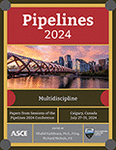Generative Adversarial Network Informed Burst Failure Risk Analysis of Oil and Gas Pipelines
Publication: Pipelines 2024
ABSTRACT
Machine Learning (ML) applications in pipeline failure risk prediction have recently shown promising results. However, obtaining actual data to train ML models is a significant challenge due to safety concerns. To overcome this limitation, this study employed a Generative Adversarial Network (GAN)-based framework to generate synthetic data based on a subset of experimental test data compiled from the literature. The burst failure risk of corroded oil and gas pipelines was determined using probabilistic approaches where pipelines were classified into two groups: (1) low risk (pf: 0−0.5) and (2) high risk (pf: >0.5). Two Random Forest (RF) models were trained and validated using a subset (70%) of actual experimental data and combined actual and synthetic data. The outcomes of this study revealed that synthetically generated data improve the accuracy of ML models and could be an alternative to actual data for developing failure risk prediction without compromising the safety of real data.
Get full access to this chapter
View all available purchase options and get full access to this chapter.
REFERENCES
Caleyo, F., Gonzalez, J. L., and Hallen, J. M. (2002). A study on the reliability assessment methodology for pipelines with active corrosion defects. International journal of pressure vessels and piping, 79(1), 77–86.
Creswell, A., White, T., Dumoulin, V., Arulkumaran, K., Sengupta, B., and Bharath, A. A. (2018). Generative adversarial networks: An overview. IEEE signal processing magazine, 35(1), 53–65.
Cronin, D. S., and Pick, R. J. (2000). Experimental database for corroded pipe: evaluation of RSTRENG and B31G. In 2000 3rd International Pipeline Conference. American Society of Mechanical Engineers Digital Collection.
CSA (Canadian Standards Association). (1999). CSA Z662-99, Oil and Gas Pipeline Systems. Ontario, Canada.
DNV (Det Norske Veritas). (1999). Corroded Pipelines: DNV Recommended Practice RP-F101, 1999. Det Norske Veritas.
Ferraz, I. M. N., Garcia, A. C., and Bernardini, F. V. C. (2008). Artificial neural networks ensemble used for pipeline leak detection systems. In International Pipeline Conference (Vol. 48579, pp. 739–747).
Gao, J., Yang, P., Li, X., Zhou, J., and Liu, J. (2019). Analytical prediction of failure pressure for pipeline with long corrosion defect. Ocean Engineering, 191, 106497.
Ghosh, J., Padgett, J. E., and Dueñas-Osorio, L. (2013). Surrogate modeling and failure surface visualization for efficient seismic vulnerability assessment of highway bridges. Probabilistic Engineering Mechanics, 34, 189–199.
Goodfellow, I. J., Shlens, J., and Szegedy, C. (2014). Explaining and harnessing adversarial examples. arXiv preprint arXiv:1412.6572.
Jeon, J. S., Shafieezadeh, A., and DesRoches, R. (2014). Statistical models for shear strength of RC beam‐column joints using machine‐learning techniques. Earthquake engineering & structural dynamics, 43(14), 2075–2095.
Kleiner, Y., and Rajani, B. (2001). Comprehensive review of structural deterioration of water mains: statistical models. Urban water, 3(3), 131–150.
Mangalathu, S., Hwang, S. H., and Jeon, J. S. (2020). Failure mode and effects analysis of RC members based on machine-learning-based SHapley Additive exPlanations (SHAP) approach. Engineering Structures, 219, 110927.
Mazumder, R. K., Salman, A. M., and Li, Y. (2021). Failure risk analysis of pipelines using data-driven machine learning algorithms. Structural safety, 89, 102047.
PHMSA. (2015). Pipeline Incident 20 Year Trends. Retrieved February, 4, 2015.
Rachman, A., Zhang, T., and Ratnayake, R. C. (2021). Applications of machine learning in pipeline integrity management: A state-of-the-art review. International journal of pressure vessels and piping, 193, 104471.
Rajani, B., and Kleiner, Y. (2001). Comprehensive review of structural deterioration of water mains: physically based models. Urban water, 3(3), 151–164.
Robles-Velasco, A., Cortés, P., Muñuzuri, J., and Onieva, L. (2020). Prediction of pipe failures in water supply networks using logistic regression and support vector classification. Reliability Engineering & System Safety, 196, 106754.
Teixeira, A. P., Soares, C. G., Netto, T. A., and Estefen, S. F. (2008). Reliability of pipelines with corrosion defects. International Journal of Pressure Vessels and Piping, 85(4), 228–237.
Villarin, M. C., and Rodriguez-Galiano, V. F. (2019). Machine learning for modeling water demand. Journal of Water Resources Planning and Management, 145(5), 04019017.
Wang, Y. Q., Wang, W. B., and Feng, Q. S. (2009). Remaining strength assessment for corroded pipelines. Corrosion and Protection-Nanchang, 29(1), 28.
Wang, Z., Pedroni, N., Zentner, I., and Zio, E. (2018). Seismic fragility analysis with artificial neural networks: Application to nuclear power plant equipment. Engineering Structures, 162, 213–225.
Xu, Q., Zhang, L., and Liang, W. (2013). Acoustic detection technology for gas pipeline leakage. Process Safety and Environmental Protection, 91(4), 253–261.
Zakikhani, K., Nasiri, F., and Zayed, T. (2020). A review of failure prediction models for oil and gas pipelines. J. Pipeline Syst. Eng. Pract, 11(1), 03119001.
Zhu, X. K. (2021). A comparative study of burst failure models for assessing remaining strength of corroded pipelines. Journal of Pipeline Science and Engineering, 1(1), 36–50.
Information & Authors
Information
Published In
History
Published online: Aug 30, 2024
ASCE Technical Topics:
- Analysis (by type)
- Business management
- Disaster risk management
- Energy engineering
- Energy infrastructure
- Engineering fundamentals
- Failure analysis
- Gas pipelines
- Infrastructure
- Lifeline systems
- Oil pipelines
- Pipe failures
- Pipe networks
- Pipeline management
- Pipeline systems
- Pipelines
- Pipes
- Practice and Profession
- Public administration
- Public health and safety
- Risk management
- Safety
Authors
Metrics & Citations
Metrics
Citations
Download citation
If you have the appropriate software installed, you can download article citation data to the citation manager of your choice. Simply select your manager software from the list below and click Download.
